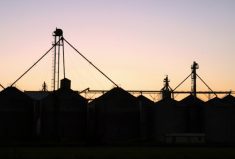A recent call from the Canadian Federation of Agriculture for more support for farmers affected by trade issues raises some interesting questions.
The CFA was responding to the announcement of $1.7 billion in direct payments to dairy producers over eight years, compensation for opening a portion of the dairy market to international competition under a series of trade deals.
While it welcomed the news, CFA also noted that other sectors have been experiencing similar pain, but no help has been coming for them, as our Geralyn Wichers reports on page 11.
Read Also

Manitoba sclerotinia picture mixed for 2025
Variations in weather and crop development in this year’s Manitoba canola fields make blanket sclerotinia outlooks hard to pin down
Pork producers, for example, are currently shut out of the Chinese market. That comes on the heels of months of lower prices because of Chinese tariffs on U.S. pork, which Canadian pork prices are based on.
And of course canola remains largely locked out of the Middle Kingdom too, ostensibly for phytosanitary reasons but likely really due to a combination of economic and political factors.
To respond to this, CFA is calling for a more robust farm safety net that addresses farm losses more quickly and fully, outside the existing business risk management structures.
Cereals Canada’s Cam Dahl’s column adjacent to this editorial adds a few more examples of farmers who are subject to trade woes including durum producers, pulse crops growers and wheat producers.
He advocates for a better and more unified approach to the problem that puts the right resources in the right place to grapple with what he characterizes as a radically changed trade environment.
The numbers certainly back up the claim times are getting tougher again down on the farm. StatsCan’s 2018 farm income statistics, the latest available, showed a 41.5 per cent drop in realized net farm income, for a total of $3.9 billion.
But little of that drop seems to have been related to trade issues. To quote StatsCan: “Rising feed, interest and labour costs together with little change in farm cash receipts pushed realized net farm income lower.”
Trade upset will definitely impact commodity sales, but even with China closed to Canadian canola for most of the latter half of the past crop year, it would appear a new record for total exports has been set, albeit with more wheat and less canola in the mix.
Clearly there should be a reaction to these accumulating trade issues. The real pain likely lies ahead as canola carry-over has grown. Less clear is what that reaction should be.
Payments to farmers, either ad hoc or through safety net programs, might be the preferred response for some. But there may be more merit in calls for a better national capacity to address trade issues.
If we’re suddenly faced with a more protectionist world, Canada will need to be ready to fend off more of these sorts of challenges in the years to come.
What’s quite certain is they’ll likely be more salable to the general public, who have frequently found themselves on the losing end of trade deals.
While Canadian wages have increased in real terms recently, that growth comes on the heels of decades of stagnation. Much of that stagnation can be directly traced to jobs offshored to new manufacturing centres such as Southern China.
With government budgets at all levels already firmly in the red, the reality is any programs are going to have to be salable to taxpayers, many of whom are already hard pressed themselves.
Someone who’s seen their good manufacturing job shipped offshore, replaced by a lower-wage service job, might look at this situation and think to themselves, ‘that’s a real shame, but things are tough all over.’
To bring them on side, agriculture is going to have to build a case that any action will benefit the country as a whole, rather than just protect relatively few farmers.
Here the case can be made for the sector as a major contributor to the national economy and a creator of jobs, including decent-paying industrial jobs in processing plants. More exports, and stable exports, will enable the sector to hire more workers here at home, a case of a rising tide lifting all boats.
There’s also perhaps an easier case to be made for readjusting the existing farm income support programs, which would almost certainly be more salable than a call for any sort of ad hoc payments.
The government changed the AgriStability trigger a few years ago from 85 per cent of reference margin to 70 per cent of reference margin. Advocating that they overshot the mark while attempting to fine-tune the program will be an easier argument to make than for new money.
In the end what’s important is that farmers be afforded an opportunity to get their income from the market.
Nobody wants to see the sector return to the status of poor cousin in the national economy.




















